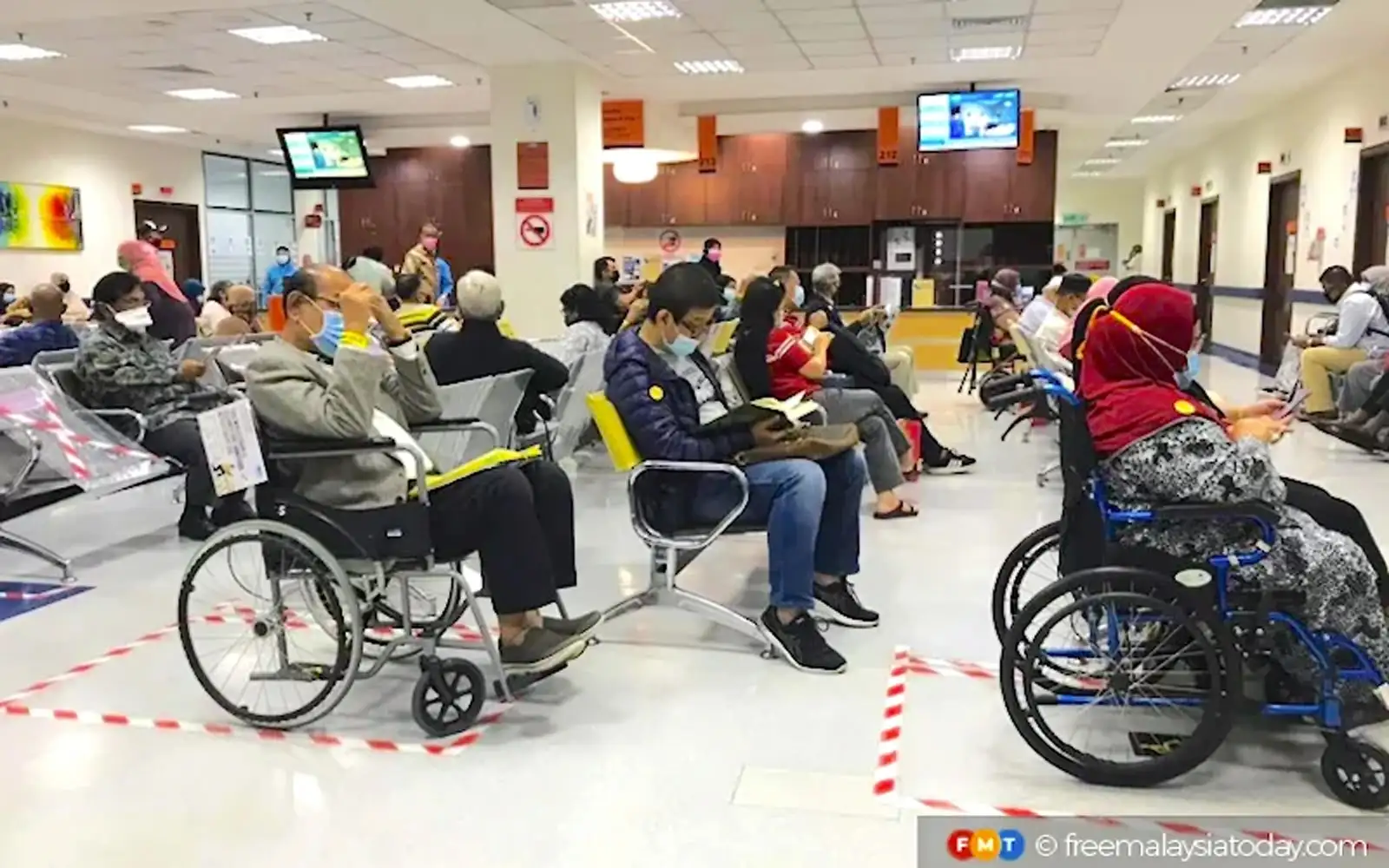
From Azrul Mohd Khalib
Malaysia’s public healthcare system took a massive hit following the Covid-19 crisis from 2020 to 2022.
At least 70% of the population continues to rely on its services, especially given the increasing prevalence of non-communicable diseases such as diabetes, cardiovascular diseases, and chronic kidney disease, as well as the growing number of elderly individuals requiring medical care.
Health workers and professionals are increasingly leaving the service for the private sector, other countries, or departing the health sector altogether. The current healthcare financing system, which dates back to the mid-1980s and relies on tax revenue, continues to subsidise up to 98% of patients’ costs.
We do not need further reminders of how fortunate we are to have an affordable healthcare system that is accessible to all, or to hear again about how inexpensive these services or treatments are.
But the truth is that nothing in healthcare has ever cost RM1 or RM5. The costs associated with consultations, nursing care, diagnostic tests, medicines, surgeries and other procedures are borne by patients, the government, taxpayers, or a combination of all three.
What we need to discuss is how to sustain, maintain and grow what we have today to ensure it meets the needs of Malaysia’s population for at least the next 30 years. The current financing mechanism has never been sustainable nor intended to be permanent.
From offices in Putrajaya to clinics and district hospitals across the country, policy decisions are often made based on what we can afford rather than what is needed to achieve the best possible health outcomes.
Recognising this, more than a dozen reports and papers commissioned by past governments since the early 1990s have recommended reforms to Malaysia’s healthcare financing to ensure it is fit for purpose and future-proofed against the expanding needs of a growing population.
Each time, the government has been unwilling to implement these recommendations, which would require bold, necessary, but unpopular actions. Instead, it has preferred to continue relying solely on taxes and the Federal Consolidated Fund, deferring tough reforms to future administrations.
Seven years ago, RM25 billion was allocated for health under the federal budget. In 2024, this amount increased to RM41.2 billion, but it is still considered an underinvestment, falling short of actual needs.
To meet the target of 5% of GDP for health allocations, at least RM85 billion would need to be secured today, representing more than a 100% increase from current levels and 22% of this year’s entire federal budget.
This is unlikely to happen.
Therefore, we need to change the conversation. We have reached the limits of a tax-based system to fund our public healthcare. We need to secure an additional, consistent source of funds to complement the existing allocation, improve access and quality, and widen the funding base to continue providing affordable healthcare for all.
The statistics department reported that as of last year, Malaysia’s average life expectancy is 74.8 years – 77.4 years for females and 72.5 years for males. Despite excess mortality due to the Covid-19 pandemic, this data reflects progress in quality of life and access to healthcare.
However, it is sobering to note that the last eight years for many people are often spent in ill health and poor quality of life.
Although 11.1% of the population is already aged 60 and above, there is no single government body with the mandate, responsibility, and necessary budget to provide for the care, wellbeing, and support of the elderly.
Neither welfare nor healthcare – under the women, family and community development and the health ministry, respectively – sufficiently covers what is needed. Aged care remains largely dependent on individuals, families, and communities, which is unsustainable.
Malaysia has been deemed ill-prepared for its status as an aged nation by 2030. Funding is urgently needed as spending for aged care is estimated to be four times higher than for the rest of the population.
What we need today is a new source of funds to support Malaysia’s healthcare needs and care for the ageing population.
One realistic option is the adoption of a national health and social insurance system, where means-tested mandatory contributions from eligible working adults would cover the costs of both health and aged care, guaranteeing a minimum level of care for all.
This would create a substantial reservoir of funds similar to the Employees Provident Fund and Social Security Organisation (Soscso). It would apply to all workers and be based on a sliding scale linked to monthly income and age.
This system would involve collective pooling of both funding and risk, enabling patients to access both private and public healthcare systems and making better use of existing resources.
It would coexist with existing private health insurance and make it possible to introduce and fund new treatments, drugs, and therapies without solely depending on the annual national budget.
These contributions would complement, not replace, existing federal allocations.
The RM1 and RM5 fees should also be eliminated. Some mistakenly believe that these fees cover the bulk of healthcare expenditure and that increasing them to RM10 and RM50 (a 900% increase!) could close the funding gap.
Unfortunately, these fees account for less than 0.5% of total health expenditure.
They are obsolete, inadequate for meaningful cost recovery, and mislead the public about the true cost of healthcare.
These charges now act as barriers and distractions to healthcare financing reform and should be removed altogether. Patients should not be required to pay anything at the point of registration.
A national health and social insurance would be a transformative innovation, potentially revolutionising Malaysian healthcare and propelling it into the 21st century rather than relying on piecemeal approaches.
We cannot depend on maintaining what we have today with a “living from national budget to national budget” mindset, facing existential questions every September and October.
A national health and social insurance could pave the way for ensuring that our healthcare workers are appropriately compensated, more nurses, doctors and medical technicians are recruited and retained, and ageing infrastructure is modernised.
It will also ensure that East Malaysia’s needs are effectively addressed, shortages of essential medicines are prevented, and discussions about life-changing and life-saving treatments shift from how we cannot access and afford them to how we can deliver these medicines to those who need them.
The government is committed to ensuring that Malaysians have access to high-quality and affordable healthcare. However, the proposal for a national health and social insurance will face the harsh reality of a continuing trust deficit among Malaysians.
Increased public funding comes with higher expectations for accountability and transparency, making it politically challenging.
Nevertheless, there will never be a perfect moment to introduce such an initiative. The UK’s National Health Service (NHS), which Malaysia is modelled after, was established in 1948, shortly after World War II, by a nation still rebuilding amidst the aftermath of conflict.
We need forward-looking, strong, and audacious leadership, as well as collaboration and partnerships between the public and private sectors.
The key benefits of a national health and social insurance should be clearly outlined: stabilising public subsidisation, allowing space for cost containment, maintaining and improving access and quality of essential services, enhancing access to innovative treatments, funding equitable access to services in the private health sector, and modernising healthcare infrastructure.
Meaningful healthcare reform is essential if we are serious about ensuring we have sufficient funds, resources, and capacity to support and invest in necessary changes. We must also be brave enough to adopt solutions outside our comfort zone.
Note: This article is Part 1 of a three-part series covering healthcare financing, human resources and health infrastructure in conjunction with the upcoming Budget 2025.
Azrul Mohd Khalib is the founder and CEO of the Galen Centre for Health and Social Policy.
The views expressed are those of the writer and do not necessarily reflect those of FMT.
kontraktor rumah
bina rumah
pinjaman lppsa
pengeluaran kwsp
spesifikasi rumah
rumah batu-bata
pelan rumah
rekabentuk rumah
bina rumah atas tanah sendiri
kontraktor rumah selangor
rumah banglo
Source
Kontraktor Bina Rumah IBS
LPPSA Kelayakan Bina Rumah Atas Tanah Sendiri Rumah Kontena Pinjaman LPPSA Rumah Pasang Siap Kontena Murah Rumah Kabin Buat Rumah Atas Tanah Sendiri Pinjamana Perumahan Kerajaan Loan LPPSA Untuk Beli Rumah Kelayakan LPPSA Rumah Kontena Pasang Siap Rumah Pasang Siap Malaysia Rumah IBS Malaysia Bina Rumah Atas Tanah Sendiri Selangor LPPSA Loan Kontraktor Rumah Kontraktor Rumah IBS Kontraktor Rumah IBS Di Selangor Kontraktor Bina Rumah di Batang Kali Kontraktor Bina Rumah di Klang Kontraktor Bina Rumah di 16 Sierra, Puchong Kontraktor Bina Rumah di Ampang Jaya Kontraktor Bina Rumah di Ara Damansara Kontraktor Bina Rumah di Balakong Kontraktor Bina Rumah di Bandar Baru Bangi Kontraktor Bina Rumah di Bandar Baru Klang Kontraktor Bina Rumah di Bandar Baru Selayang Kontraktor Bina Rumah di Bandar Botanic Kontraktor Bina Rumah di Bandar Bukit Puchong 1, Puchong Kontraktor Bina Rumah di Bandar Bukit Puchong 2, Puchong Kontraktor Bina Rumah di Bandar Bukit Puchong, Puchong Kontraktor Bina Rumah di Bandar Bukit Tinggi Kontraktor Bina Rumah di Bandar Country Homes Kontraktor Bina Rumah di Bandar D’Alpinia, Puchong Kontraktor Bina Rumah di Bandar Kinrara BK 1 Sehingga 6, Puchong Kontraktor Bina Rumah di Bandar Mahkota Cheras Kontraktor Bina Rumah di Bandar Nusa Rhu Kontraktor Bina Rumah di Bandar Puchong Utama, Puchong Kontraktor Bina Rumah di Bandar Puteri Puchong, Puchong Kontraktor Bina Rumah di Bandar Putra Permai Kontraktor Bina Rumah di Bandar Rasa Kontraktor Bina Rumah di Bandar Rinching Kontraktor Bina Rumah di Bandar Saujana Utama Kontraktor Bina Rumah di Bandar Seri Putra Kontraktor Bina Rumah di Bandar Sungai Buaya Kontraktor Bina Rumah di Bandar Sungai Long Kontraktor Bina Rumah di Bandar Sunway Semenyih Kontraktor Bina Rumah di Bandar Tasik Kesuma Kontraktor Bina Rumah di Bandar Teknologi Kajang Kontraktor Bina Rumah di Bandar Teluk Datok Kontraktor Bina Rumah di Bandar UtamaKontraktor Bina Rumah di Banting Kontraktor Bina Rumah di Batang Kali Kontraktor Bina Rumah di Batu 9 Cheras Kontraktor Bina Rumah di Batu Arang Kontraktor Bina Rumah di Bernam Jaya Kontraktor Bina Rumah di Bukit Antarabangsa Kontraktor Bina Rumah di Bukit Beruntung Kontraktor Bina Rumah di Bukit Gasing Kontraktor Bina Rumah di Bukit Komanwel Kontraktor Bina Rumah di Bukit Lanjan Kontraktor Bina Rumah di Bukit Raja Kontraktor Bina Rumah di Bukit RimauKontraktor Bina Rumah di Bukit Sentosa Kontraktor Bina Rumah di Bukit Tagar Kontraktor Bina Rumah di Bukit Tampoi Kontraktor Bina Rumah di Country Heights Kontraktor Bina Rumah di Damansara Damai Kontraktor Bina Rumah di Damansara Intan Kontraktor Bina Rumah di Damansara Jaya Kontraktor Bina Rumah di Damansara Perdana Kontraktor Bina Rumah di Damansara Utama Kontraktor Bina Rumah di Denai Alam Kontraktor Bina Rumah di Dengkil Kontraktor Bina Rumah di Dusun Tua Kontraktor Bina Rumah di Gombak SetiaKontraktor Bina Rumah di I-City Kontraktor Bina Rumah di Kajang Kontraktor Bina Rumah di Kalumpang Kontraktor Bina Rumah di Kampung Jenderam Hilir Kontraktor Bina Rumah di Kampung Kubu Gajah Dalam Kontraktor Bina Rumah di Kelana Jaya Kontraktor Bina Rumah di Kinrara Kontraktor Bina Rumah di Klang Kontraktor Bina Rumah di Kota Damansara Kontraktor Bina Rumah di Kuala Kubu Bharu Kontraktor Bina Rumah di Kuang Kontraktor Bina Rumah di Kwasa Damansara Kontraktor Bina Rumah di Lembah Beringin Kontraktor Bina Rumah di Mutiara Damansara Kontraktor Bina Rumah di Pandan Indah Kontraktor Bina Rumah di Pelabuhan Klang Kontraktor Bina Rumah di Pinggiran Cyberjaya Kontraktor Bina Rumah di Puchong, Selangor Kontraktor Bina Rumah di Bandar Puteri Bangi Kontraktor Bina Rumah di Rawang, Selangor Kontraktor Bina Rumah di Sungai Rinching Kontraktor Bina Rumah di Sabak, Selangor Kontraktor Bina Rumah di Sekinchan Kontraktor Bina Rumah di Selayang Kontraktor Bina Rumah di Semenyih Kontraktor Bina Rumah di Serendah Kontraktor Bina Rumah di Seri Kembangan Kontraktor Bina Rumah di Subang Bestari Kontraktor Bina Rumah di Subang Jaya Kontraktor Bina Rumah di Taman Tasik Semenyih Kontraktor Bina Rumah di Tanjung Sepat Kontraktor Bina Rumah di Teluk Datok Kontraktor Bina Rumah di Teluk Panglima Garang Kontraktor Bina Rumah di Tropicana Kontraktor Bina Rumah di UEP Subang Jaya Kontraktor Bina Rumah di Ulu Yam Kontraktor Bina Rumah di Gombak Kontraktor Bina Rumah di Hulu Langat Kontraktor Bina Rumah di Hulu Selangor Kontraktor Bina Rumah di Kuala Langat Kontraktor Bina Rumah di Kuala Selangor Kontraktor Bina Rumah di Petaling Jaya Kontraktor Bina Rumah di Sabak Bernam Kontraktor Bina Rumah di Sepang Kontraktor Bina Rumah di Selangor Kontraktor Bina Rumah di Kuala Lumpur Kontraktor Bina Rumah di Shah Alam Kontraktor Bina Rumah di Kapar Kontraktor Bina Rumah di Meru Kontraktor Bina Rumah di Puncak Alam Kontraktor Rumah Bina Rumah Pinjaman LPPSA Pengeluaran Kwsp Spesifikasi Rumah Rumah IBS Pelan Rumah Rekabentuk Rumah Bina Rumah Atas Tanah Sendiri Kontraktor Rumah Selangor Rumah Banglo Kos Bina Rumah Atas Tanah Sendiri Syarat Bina Rumah Atas Tanah Sendiri LPPSA Bina Rumah Atas Tanah Sendiri Kelantan Bina Rumah Atas Tanah Sendiri Sarawak Bina Rumah Atas Tanah Sendiri Kerajaan Bina Rumah Atas Tanah Sendiri Sabah Pinjaman Bina Rumah Atas Tanah Sendiri Bina Rumah Atas Tanah Sendiri Kedah Bina Rumah Atas Tanah Sendiri Kelantan Bina Rumah Atas Tanah Sendiri Selangor Bina Rumah Atas Tanah Sendiri Kedah Bina Rumah Atas Tanah Sendiri Johor Bina Rumah Atas Tanah Sendiri Terengganu Bina Rumah Atas Tanah Sendiri Perak Bina Rumah Atas Tanah Sendiri Sarawak Bina Rumah Atas Tanah Sendiri MelakaBina Rumah Atas Tanah Sendiri Negeri Sembilan Bantuan Bina Rumah Atas Tanah Sendiri Kos Bina Rumah Atas Tanah Sendiri Pinjaman Bina Rumah Atas Tanah Sendiri Syarat Bina Rumah Atas Tanah Sendiri LPPSA Loan Bina Rumah Atas Tanah Sendiri Permohonan Bina Rumah Atas Tanah Sendiri Cara Bina Rumah Atas Tanah Sendiri Skim Bina Rumah Atas Tanah Sendiri 2021 Pakej Bina Rumah Atas Tanah Sendiri Kelebihan Bina Rumah Atas Tanah SendiriBina Rumah Bawah 100k Kelantan Bina Rumah Sendiri Kos Bina Rumah 2022 Kos Bina Rumah Atas Tanah Sendiri Bina Rumah Atas Tanah Sendiri Kelantan Pengalaman Buat Loan Untuk Bina Rumah Bina Rumah Murah Kontraktor Bina Rumah Bina Rumah Atas Tanah Sendiri Bina Rumah Bajet 50k Bina Rumah Atas Tanah Sendiri Selangor Bina Rumah Sendiri Tanpa Kontraktor Bina Rumah Bajet 30k Bina Rumah Atas Tanah Sendiri Kedah Bina Rumah Bajet 10k Bina Rumah Bajet 50k Selangor Bina Rumah SendiriBantuan Bina Rumah Atas Tanah SendiriKos Bina Rumah 2022Kos Bina Rumah 20×30 Pinjaman Bina Rumah Atas Tanah SendiriPengalaman Buat Loan Untuk Bina Rumah Kalkulator Bina Rumah Sendiri Pengeluaran Kwsp Untuk Bina Rumah Loan LPPSA Untuk Bina Rumah Kos Bina Rumah Bajet Kos Bina Rumah Kampung Bina Ayat Rumah Tangga Binatang Di Dinding Rumah Pinjaman LPPSA Beli Tanah Pinjaman LPPSA Ubahsuai Rumah Pinjaman LPPSA Beli Rumah Pinjaman LPPSA Bina Rumah Pinjaman LPPSA Untuk Beli Tanah Pinjaman LPPSA Untuk Bina Rumah Pinjaman LPPSA Beli Tanah Pertanian Pinjaman LPPSA Jenis 5 Pinjaman LPPSA Atau Bank Semak Baki Pinjaman LPPSA Semakan Baki Pinjaman LPPSA Semak Baki Pinjaman LPPSA Sms Jenis Pinjaman LPPSA Syarat Pinjaman LPPSA Kelayakan Pinjaman LPPSA Jadual Kelayakan Pinjaman LPPSA Tuntutan Pindah Rumah Pinjaman LPPSA Syarat Pinjaman LPPSA Bina Rumah Borang Tuntutan Pindah Rumah Pinjaman LPPSA Pinjaman Perumahan LPPSA Pinjaman Ubahsuai Rumah LPPSA Pinjaman Kedua LPPSA Pinjaman Kedua LPPSA Untuk Ubahsuai Rumah Pinjaman Perumahan LPPSA Vs Bank Pinjaman Bank Ke LPPSA Pinjaman Bersama LPPSA Pengiraan Kos Bina Rumah Sendiri Cara Jimat Buat Rumah Sendiri Bina Rumah Sendiri Tanpa Kontraktor Pengalaman Bina Rumah Sendiri Kos Bina Rumah Atas Tanah Sendiri Bina Rumah Atas Tanah Sendiri Sabah Pinjaman Bina Rumah Atas Tanah Sendiri Bina Rumah Atas Tanah Sendiri Kerajaan Kos Bina Rumah 20×30 Kos Bina Rumah Paling Murah 2022 Harga Upah Tukang Rumah 2022 Kos Bina Rumah Kampung Kos Bina Rumah Bajet Anggaran Kos Bina Rumah 3 Bilik Kos Bina Rumah Atas Tanah Sendiri Kalkulator Bina Rumah Sendiri Rate Loan Rumah Kelayakan Loan Rumah Pinjaman Perumahan Public Bank Interest Bank Loan Rumah 2023 Interest Loan Rumah 2023 Berapa Lama Bank Proses Loan Rumah Cara Kira Interest Loan Rumah Bank Loan Rumah Terbaik Interest Bank Loan Rumah Public Bank Loan Rumah Affin Bank Loan Rumah Letter Offer Bank Loan Rumah Rhb Bank Loan Rumah Calculator Hong Leong Bank Loan Rumah Mbsb Bank Loan Rumah Rhb Bank Loan Rumah Cimb Bank Loan Rumah Agrobank Loan Rumah Bank Mana Senang Lulus Loan Rumah Bank Rakyat Loan Rumah Bank Islam Loan Rumah Bank Terbaik Untuk Loan Rumah Bank Call Untuk Pengesahan Loan Rumah Bank Muamalat Loan Rumah Bank Yang Mudah Lulus Loan Rumah Bank Akan Call Untuk Loan Rumah Bank Mbsb Loan Rumah Bank Islam Loan Rumah Contact Number LPPSA



